A Murmur of Bees
Christopher O’Toole
Principle Photography by Edward Ross
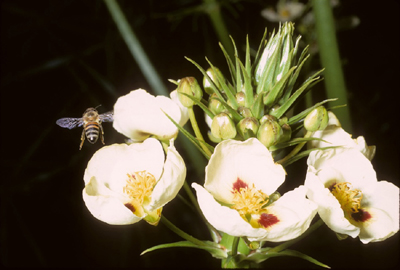
The murmur of a bee
A witchcraft yieldeth me.
If any ask me why,
'T were easier to die
Than tell.The red upon the hill
Taketh away my will;
If anybody sneer,
Take care, for God is here,
That's all.The breaking of the day
Addeth to my degree;
If any ask me how,
Artist, who drew me so,
Must tell!—Emily Dickenson
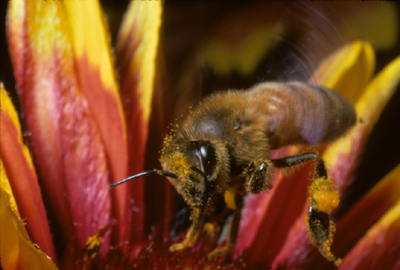
Rights available: World
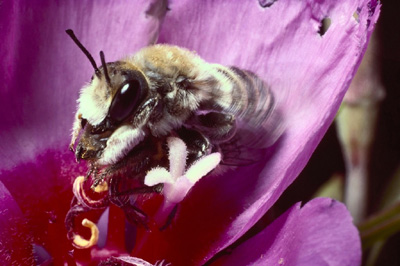
Specifications
240 pages
125 color photographs
3 appendices
index
Dimensions: 11 x 8.5 inches
Table of Contents
Introduction
Acknowledgements
1. What are bees?—The Wasp Inheritance
[The basics for central place foragers: the nesting instinct; on-board
computing facility; sun-compass orientation; a sense of time.]
2. The business of being a bee
[Vegetarian wasps: body changes for a vegetarian lifestyle; short tongues
and long tongues; pollen handling kit; size-related guilds]
The many ways of being a bee:
3. Solitary versus social
4. Miners and masons
5. Leafcutters and carpenters
6. Taking the altruism out of altruism: the road to sociality
7. Bees and flowering plants
[A complex of life-sustaining networks; the pollination market place:
retailers (plants) consumers (bees) currencies (flying ability, memory).
The two bee guilds: small, low energy, short distance foragers; large,
high energy, long-distance foragers.]
8. Squash bees and other specialists
[Bees which major on particular flowering plant families, genera or even
species; orchid bees.]
9. The male of the species
[A multiplicity of mating strategies: simple patrols; scramble competition;
aggressive territoriality; the role of scent; anti-aphrodisiacs.]
10. The enemies of bees
[Nest associates: cleptoparasites; cuckoo bees]
11. Bees and People
[Historical]
12. Bees in Folklore
13. Bees in Folk and Modern Medicine
14. The Conservation of Bees
[The decline of bees in general and honeybees in particular; bees in human
ecology: pollinators old and new; bee conservation; urban bees]
15. Bee projects
[The backyard bee scientist]
Appendix 1: Museums with world class collections of bees.
Appendix 2: Suppliers of products for bee projects.
Appendix 3: Bee-related web sites
References (by chapter)
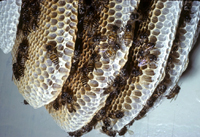
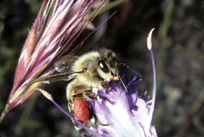
Introduction
Thanks to high quality natural history programs on television, most of us are broadly familiar with the ecology of the big game species in Africa, especially those in the eastern savannahs. Only now, though, are we beginning to unravel the ecology of the little game, the insects, whose ecological services support and maintain habitats.
This is important: our antecedents evolved in response to
the opportunities and challenges presented by the savannahs of East Africa
and they did so by courtesy of the pollinating services of bees. Worldwide,
there are at least 16-20,000 species of bee and they continue to play
vital roles in human ecology.
When early man migrated out of Africa, the habitats he encountered may
have been different from those in Africa and the bees and plants were
certainly different; nevertheless, the habitats he colonized were created
and maintained by the same co-evolved, life-sustaining network of bee-plant
relationships.
If bees help maintain habitats, they are also more directly relevant as
food. Our closest relatives, the two species of chimpanzee, rob honeybee
and stingless bee nests for honey and larvae and doubtless early humans
did the same. And these foods are important for those modern humans who
still enjoy the hunter-gatherer lifestyle. A settled life-style led to
the active management of honeybees and stingless bees as sources not only
of food, but also useful products such as wax and propolis. Beekeeping
with the honeybee, Apis mellifera, was a well-established craft
in ancient Egyptian culture and, independently, the Mayans of Mesoamerica,
developed apiculture with a species of stingless bee, Melipona beechei.
It was only as late as the 18th century that people began to understand and value the pollination services of bees. This knowledge grew and developed in Britain and Europe and led to beehives being placed in fruit orchards specifically for pollination purposes and growers began to enjoy higher fruit yields.
Today, in the United States, bees pollinate 130 crop species and worldwide more than 400 crops. Although most of this managed pollination is by honeybees, there is a growing use of other, “wild” species. Even where these bees are not actively managed, they still, in their “wild” state, make a valuable contribution to crop pollination. The vital role of bees in human ecology is underlined by the estimate that every third mouthful of human food is dependent on the pollinating services of bees, much of which can be attributed to solitary bees.
The importance of bees in human affairs is not limited to
their roles as pollinators. They also have vital roles in maintaining
habitats and floras to which we attribute aesthetic and recreational value.
Thus there are many powerful arguments for the active conservation of
our native bee faunas.
The association of bees and man has thus been long and close. For me,
it began as a 12 year-old, in the coastal sand dunes 15 miles north of
Liverpool. It was here that I made my first discoveries about bees. Even
now, as a full-grown 64-year old, give me a flower-rich meadow and mass
of pollen-plundering bees and I am as happy and excited as that boy in
the Lancashire dunes. And there is much to be excited about…
Bees have an impressive diversity of size, form and nesting behavior. They can be found in high, alpine and sub-arctic regions, rainforest, savannahs, steppes and deserts. The greatest diversity of species occurs in shrub communities in regions with a Mediterranean-type climate: short, mild winters, warm springs and hot, dry summers.
The familiar bees–honeybees and bumblebees – are
highly social insects, where a single female lives in a colony with hundreds
or even many thousands of sterile females or workers. All of these bees
process nectar to make honey, which they store in wax cells or pots. Together
with their relatives, the tropical stingless bees, they account for only
1,200 of the estimated 16-20,000 species.
The vast majority of bees, therefore, are non-social and are usually referred
to as solitary bees. That is, each nest is the work of a single female
working alone; there is no caste of workers and they do not make honey,
though they usually mix some nectar with their stored pollen. In the scheme
of things, therefore, the production and storage of honey is very unusual.
Many species excavate nests in the ground, others construct exposed nests on rocks or vegetation while others nest in pre-existing cavities such as hollow plant stems, beetle borings in dead wood; some specialists use snail shells. The majority of ground nesting bees use their own glandular secretions to line the cells in which the store pollen and nectar and in which their larvae develop. By contrast, surface and cavity-nesting species collect, according to species, mud, small pebbles, plant resins, a mastic of chewed leaves, or various combinations of these. Some use pieces of leaf and plant and/or animal hairs.
Proponents of intelligent design would have a field day citing the structural features bees use to handle these building materials. They would also be inspired by the structures female bees use in gathering and transporting the nectar and pollen they collect from flowers. Many bee species have highly specialized relationships with a restricted range of plant species and they have even more specialized structures to manage the handling of pollen from virtually inaccessible sources.
If specialization is a recurrent theme in the nesting and
foraging behavior of females, the same is true for males in their mate
seeking behavior; all of the behaviors recorded in birds and mammals—scramble
competition, le displays and aggressive territoriality - are also found
among male bees.
Male bees rival flowers as perfumers, secreting a range of usually species-specific
scents as part of their sexual signaling systems. They also have a range
of sometimes bizarre structures which act as wicks for the dispersal of
these scents. We will see how at least one suite of these male secondary
sexual characters is predictive of the nesting behavior of their females.
Bees are rich in such quirky features. Some are counter-intuitive. For
example, can some bees, those denizens of sunshine, actually nest in dark,
caves, beyond the twilight zone? Is it really true that there are nocturnal
bees and some that spend some time under water? How is it that the successful
pollination of small flowers in wadis in the Negev desert of Israel and
Palestine can depend on the nesting success of bees which never visit
them? How can it be that the pollination success of the economically important
Brazil nut trees in Amazonia is partially dependent on the successful
intertwining of the sex lives of male euglossine bees, which never visit
the nut flowers, with those of epiphytic orchids which do not grow on
the trunks and branches of Brazil nut trees? And do honeybees actually
have something to tell us about the search for extra-terrestrial intelligence
(SETI)?
With this book I want to share the pleasures I have enjoyed over the years while immersed in the world of bees, those appealing, intriguing animals, whose diversity of form and behavior is such eloquent testimony to the fine-tuning of natural selection.
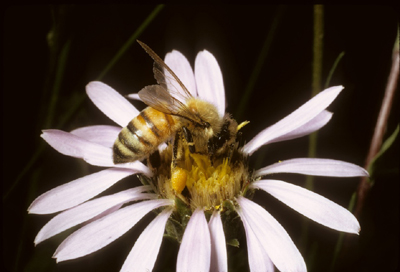
Christopher O’Toole is an entomologist, author and effective,
entertaining speaker for general audiences on the subjects of conservation,
insect behaviour and evolution and the importance of insects to human
survival.
Formerly based at the Hope Entomological Collections of the Oxford University
Museum of Natural History, his research has been centered on the systematics,
biogeography and floral relations of solitary bees. This has involved
long-term fieldwork collaboration with pollination botanists in Israel
and Palestine. His work has also taken him to the deserts of the south-western
United States and the cerrado of Brazil.
O’Toole have also worked on developing the use of the Red Mason Bee, Osmia rufa, as a managed pollinator of orchard crops in the UK, Belgium and Poland. Since 2006, he have been developing the use of the Blue Orchard Bee, Osmia lignaria, as an alternative to the honeybee as a managed pollinator of almonds in California.
He have contributed to many major television projects as scientific consultant, including several programmes in the Anglia-TV Survival series (1970’s), The Birth of the Bees (1986) for the BBC Natural History Unit (both with Oxford Scientific Films and Emmy award winning cameraman Sean Morris) and on two of Sir David Attenborough’s series, Life on Earth (1979) and Trials of Life (1990), working on location in Utah with both Sir David and Emmy winning cameraman Kevin Flay for the former. He was the senior Scientific Consultant on the six-part BBCTV series Alien Empire (1995) and wrote the book of the series, published by BBC Books.
He was also the scientific consultant on the feature film Angels and Insects, the film of A. S. Byatt’s novel of the same name, where I once again worked with wild-life cameraman Kevin Flay. O’Toole wrote and directed The Red Mason Bee, a 30-minute film on the natural history of the solitary bee Osmia rufa. This won the Bronze Medal at Apimondia, Dublin, 2005.
Lecturing for general audiences
O’Toole has lectured to a wide range of local natural history societies, conservation groups and apicultural organisations. In the context of the “Arts meets Science” projects, He has worked with the artistic partnership of Peter Chatwin and Pamela Martin. They shadowed me when I was conducting field work in the UK and southern Italy. This collaboration generated two touring exhibitions and lecture series:-
Books by Chris O’Toole
Children’s titles:
1985 Discovering Bees and Wasps. Wayland, Hove.
1986 Discovering Flies. Wayland, Hove.
1986 Discovering Ants. Wayland, Hove.
1988 The Dragonfly over the Water. Methuen, London.
1988 Where Animals Live: The World of Dragonflies. Gareth Stevens Publishing, Milwaukee. [With Virginia Harrison]
1990 The Honeybee over the Meadow. Belitha-Methuen, London.
Adult natural history/popular science:
1985 Insects in Camera: a Photographic Essay on Behaviour. Oxford University Press, Oxford, UK.
1986 The Encyclopaedia of Insects. Geo. Allen & Unwin, London, UK. [as Editor and principal writer]. Simultaneous co-edition published in USA by Facts of File. [Subsequent foreign language editions: Finnish, Swedish, Norwegian, German, French, Spanish, Portuguese, Italian, Japanese.]
1987 The Holiday Naturalist in France. The Stephen Green Press, Lexington. Massachusetts. [as senior author with Linda Losito]
1987 The Holiday Naturalist in Italy. The Stephen Green Press, Lexington. Massachusetts. [as senior author with Linda Losito]
1988 The Holiday Naturalist in Greece. The Stephen Green Press, Lexington. Massachusetts. [as senior author with Linda Losito]
1988 The Holiday Naturalist in Spain. The Stephen Green Press, Lexington. Massachusetts. [as senior author with Linda Losito]
1991 Bees of the World. Blandford, London, UK. Blandford-Cassell, London; Facts on File, New York. [As senior author with Anthony Raw].
1995 Alien Empire: An Exploration of the Lives of Insects. BBC Books, BBC Worldwide Publishing, London, UK. [Accompanied the BBC1 six-part series of the same name. Subsequent foreign language edition: German]
2000 The Red Mason Bee: Taking the Sting out of Beekeeping. Osmia Publications, Banbury.
2001 The Mason Bees: taking the sting out of beekeeping. A practical guide for gardeners and fruit growers to the propagation and management of the Blue Mason bee, Osmia lignaria and its relatives, docile and efficient pollinators. Osmia Publications, Banbury.
2002 Bumblebees. Osmia Publications, Banbury.
2002 The Encyclopaedia of Insects and their Allies. Oxford University Press, Oxford, UK. (as Editor and principal writer). [Also re-published later as an imprint of Firefly Books]
2004 Garden Beetles. Osmia Publications, Rothley. [With Darren Mann, co-author]
2006 North American Wildflowers for Wildlife. Osmia
Publications, Sileby, Leicestershire. [As senior author, with Jenny Steel]
Click here to return to book.